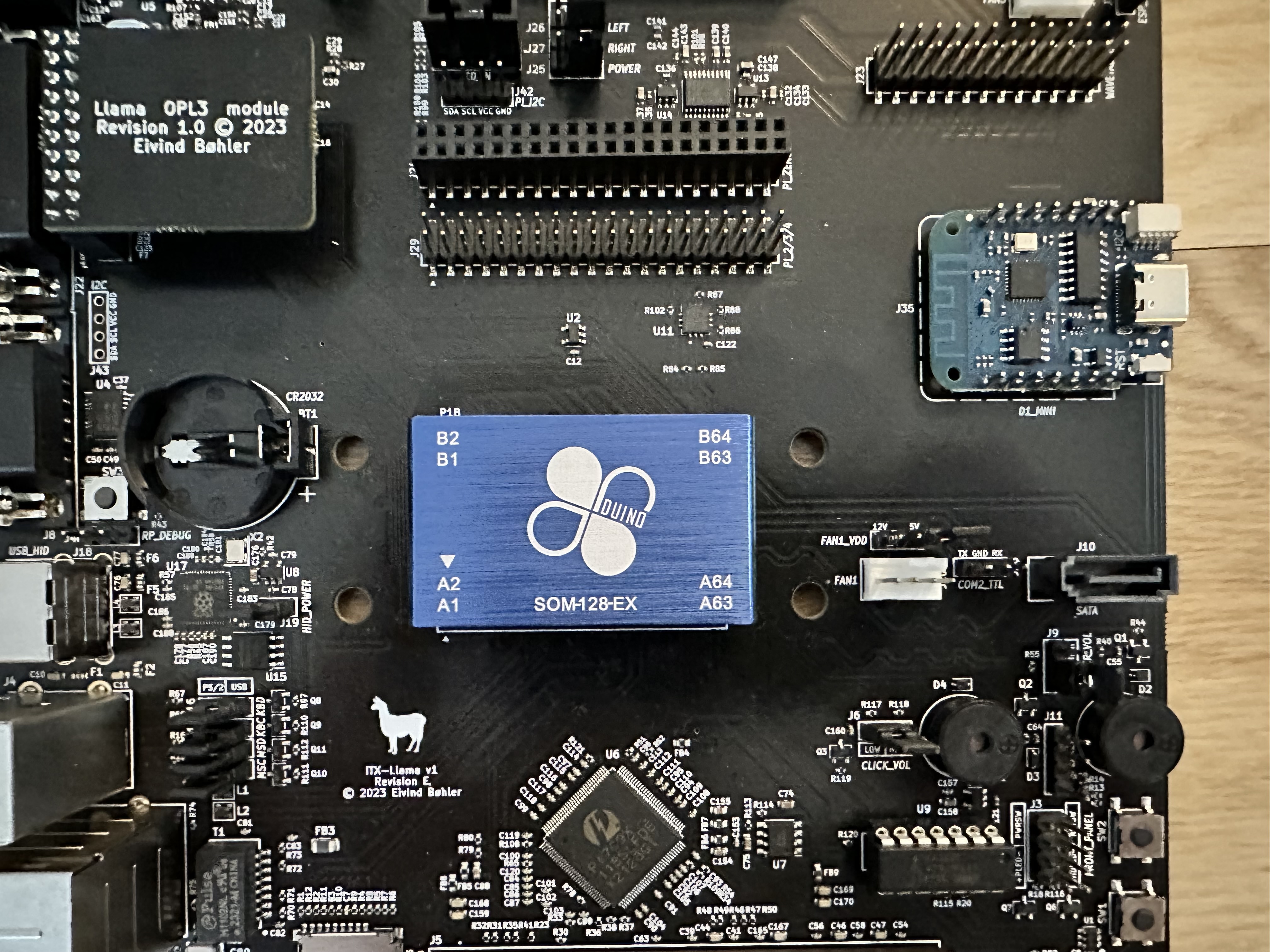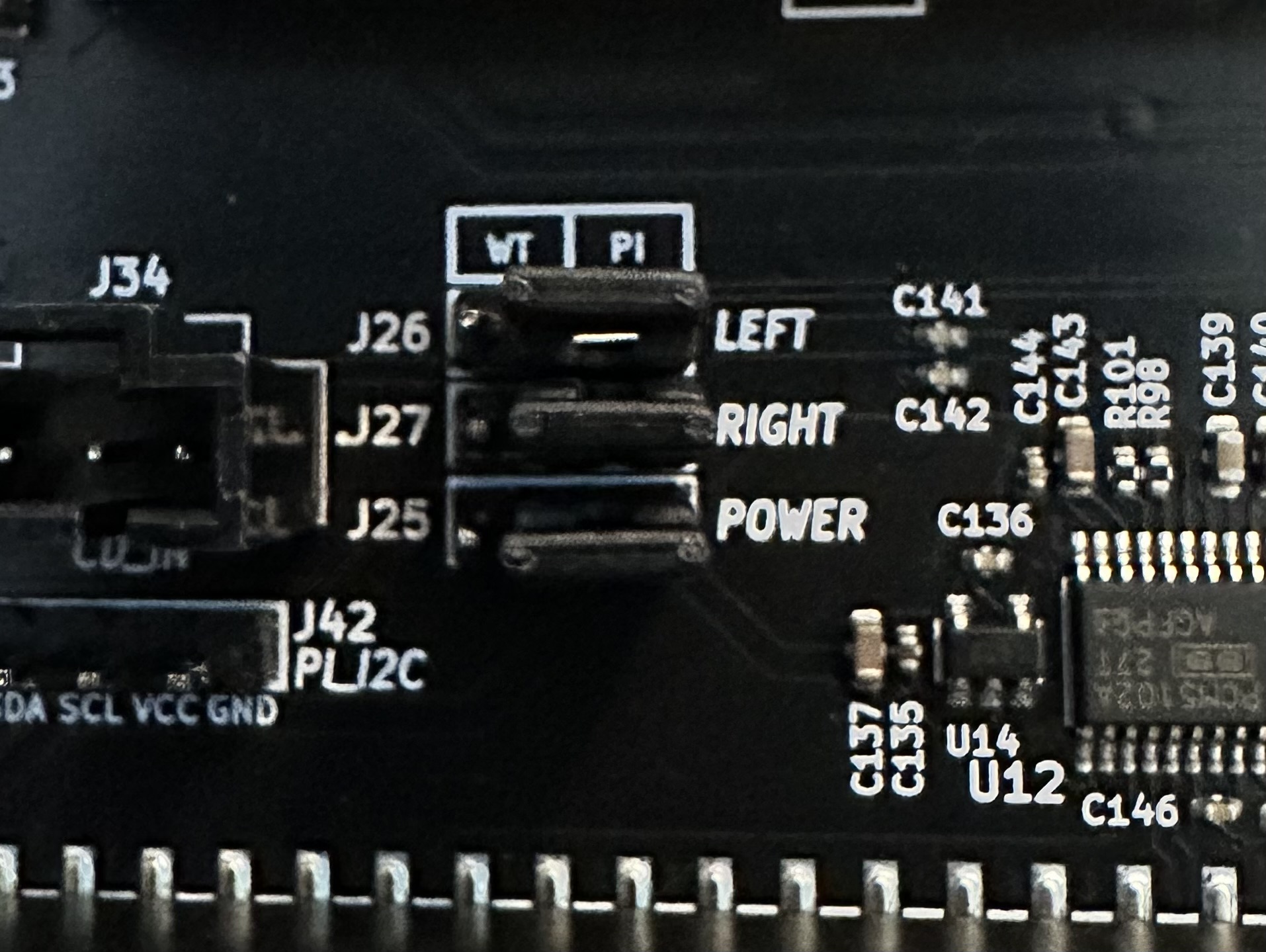Note
This document is still a work in progress.
For feedback, suggestions, etc. - please add a post to the Vogons thread.
- Installing the SOM
- Jumper Configuration
- Flashing the BIOS
- DOS
- Windows 98
- Windows 98 Drivers
- Fans
- mt32-pi
When installing the Vortex86EX SOM, carefully align the module as shown in the image below, and gently push it down on the 64 pins.
Note that the pins on the motherboard are quite thin and fragile, and if you misalign the SOM or use excessive force, they'll likely bend or break.
Take your time, be careful and double-check the placement before proceeding further!
The board should come preinstalled with all the jumpers necessary.
For changing the configuration, here's a quick walkthrough of the different jumpers and their functionality.
Jumpers: J7, J12, J15, J16
If you want to use a real PS/2 keyboard connected to the purple PS/2 port, place the two topmost jumpers (J15 and J16) to the leftmost position ("PS/2"). For USB HID keyboard connected to one of the white USB ports (between the PS/2 and serial port), place the jumpers to the rightmost side ("USB"). Same goes for PS/2 mouse and jumpers J7 and J12.Jumpers: J39, J40
If you want to use an external audio source connected to the blue 3.5mm jack port, place both jumpers to the leftmost position ("EXT"). For using a Raspberry Pi Zero2 or Wavetable board as line-in to the sound card, place the two jumpers to the rightmost position ("INT").Jumpers: J25, J26, J27
For using a Raspberry Pi (Zero2, 3 or 4) for converting MIDI to analog audio, place the three jumpers to the rightmost position ("PI"). For using a wavetable board, place the jumpers to the leftmost position ("WT").If you've purchased the Vortex86EX system-on-module (SOM) from DMP, ICOP, etc - you need to flash the BIOS first.
Since the BIOS that comes pre-installed on the SOM is set up for another pinout/configuration, the microSD card slot isn't availble yet, and you need to use a USB flash drive for this part.
Format the flash drive with a DOS-bootable FAT16/32 partition and copy over the ANYBIOS.EXE and ITXBIOS.ROM files.
Alternatively (and easier), just do a block-level transfer of the INITBIOS.IMG file to the flash drive using Balena Etcher, dd or something similar.
Then place the flash drive in one of the USB ports (the ones below the RJ45 port). Plug a USB keyboard in the other port. Note: at this point, a keyboard plugged into one of the two HID-only (white) ports won't work, you need to use the ones below the RJ45 port!
Power up the system, and hopefully you'll get a DOS prompt. From there just type:
anybios w itxbios.rom
Once done, shut down the computer, remove the flash drive and move the keyboard to one of the HID ports.
Follow these instructions to set up DOS on a microSD card, SATA drive or USB flash drive:
(Note: a SATA drive is faster, but this isn't that important in DOS. I recommend using a microSD card, because you'll be able to use the "clicker" feature to simulate the seeking sounds of an old spinning drive, if you're interested in that)
- Turn off the system, insert a drive of choice.
- Boot the system, press ESC to bring up the boot menu.
- Choose the Virtual Floppy drive.
- Run
fdisk, select and partition the drive however you want. Make sure to have at least one primary partition, and make itActive. - Quit fdisk and reboot the system.
- Once again, boot the system using the Virtual Floppy drive.
- Run
fdisk /mbrto write the correct MBR bytes to the new drive. - Run
format c: /sto format the new drive and copy over the necessary system files. - Shut down the machine and remove the drive.
- Copy over DOS and whatever else you want from a modern computer.
The Crystal CS4237B sound chip is automatically initialized and configured from the BIOS, so you don't need any drivers in DOS.
If you wish to change any of the mixer settings, use CWDMIX.EXE.
Before proceeding, I'd strongly recommend using a SATA drive for Windows 98, as the performance is noticably better than running from an SD card or USB drive.
Download Windows 98 SE from WinWorldPC. Product keys are there as well.
Prepare a bootable DOS drive (see the DOS section above), copy the WIN98 folder over to the drive and run the SETUP.EXE from within.
Note: at some point during the installation, you'll get a crash. This is due to the IDE driver being incompatible with the Vortex86EX's IDE controller.
Reboot, and choose "Safe Mode". From within Win98, install the TBPLUS drivers from R. Loew and then reboot again and complete the installation.
An easier way is to install Windows 98 SE is using a version I've prepared which has the IDE drivers "slipstreamed" (meaning that Windows will use the updated drivers automatically).
If you installed the TBPlus drivers during the Windows 98 installation, or used the slipstreamed Windows 98 installer you're all set. If not, install the TBPlus drivers.
In the BIOS Settings, you can choose to have USB flash drives appear to the system as fixed disks.
With this setting enabled, they'll show up as regular hard drives in DOS and Windows.
If you turn this setting off, you can use flash drives as removable storage in Windows 98. Use nusb36e.exe to install the required drivers.
Run SETUP.EXE from the Crystal Audio driver folder.
From Device Manager, find the Ethernet device and install the RDC R6040 driver.
The Vortex86EX SOM doesn't draw much power, and shouldn't require active cooling if running at or below 300 MHz.
If you do wish to add one or more fans, the motherboard has three separately controllable 4-pin PWM fan connectors:
Note: Take care not to supply 12V to a 5V fan - you'll likely fry it.
If you want to use a Raspberry Pi as an MT-32 or MIDI synthesizer, download and install the mt32-pi bare-metal software on the Pi, and plug it into the motherboard.
If you go with a Pi Zero 2 (the easiest and cheapest option), make sure to solder the 40-pin connector to the bottom side of the Pi, as seen here:
Look at the mt32-pi github page for setup, configuration options etc.
As a minimum, you want to set the output of the mt32-pi as type "i2s":
output_device = i2s
Use the mt32-pi-control software from DOS to switch between MT-32 and MIDI mode.







